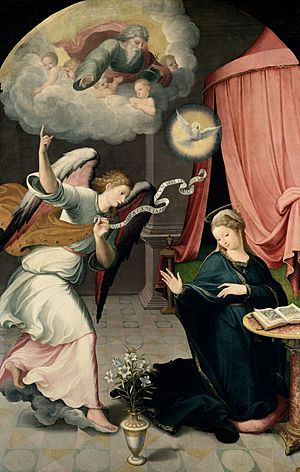Juan Correa de Vivar facts for kids

Juan Correa de Vivar (around 1510 – April 16, 1566) was an important Spanish painter. He lived during the Renaissance period in Spain. His art often showed colorful scenes and delicate figures.
Life of Juan Correa de Vivar
Juan Correa de Vivar was born in a town called Mascaraque in Spain. This was around the year 1510. Records show that his family was quite wealthy. When Juan was about 17 or 18 years old, he joined the art studio of a famous painter named Juan de Borgoña. There, he met other artists, including a friend named Pedro de Cisneros.
Juan's brother, Eufrasia, and Eufrasia's son, Rodrigo, also became artists. Rodrigo even learned from his uncle Juan. After Juan's death, Rodrigo finished some of his uncle's artworks. Juan owned a large house and land in Mascaraque. He did a lot of his painting there. He often traveled, but always stayed near the Toledo area.
Juan was a married man and very religious. This can be seen in his will, which was found in the church records of Mascaraque. When he died, Juan divided his belongings between his nephew Rodrigo and the church in Mascaraque.
Juan was a respected painter during his lifetime. However, many records about him were lost over time. His life and works became known again in 1800. This happened when an art historian named Ceán Bermudez published a dictionary of famous artists. He included a short article about Juan's paintings and how they were influenced by Italian art. Most of the details about his life were put together in the 20th century.
Records show that Juan died on April 16, 1566, in a place called San Miguel. His body was brought back to Mascaraque. He was buried in the same spot as his parents. Many artists came to his funeral. These included architects Alonso de Covarrubias and Nicolás de Vergara. The sculptor Francisco de Linares and painters Diego de Aguilar and Blas Pablín were also there.
Artworks and Painting Style
Juan Correa de Vivar was greatly influenced by the famous Italian artist Raphael. Juan used Raphael's style of bright colors and soft, smooth figures. One of Juan's most important works was a large altarpiece for a church in Almonacid de Zorita. He worked on this with Alonso de Covarrubias. Sadly, this artwork was destroyed during a war in 1936–39.
Over the years, Juan's painting style changed. It became more dynamic, meaning it showed more movement. He started using a style called Mannerism. This allowed him to create figures that looked like they were moving with great force.
Many of Juan's well-known paintings are found in the province of Toledo. These include the altarpiece of San Roque in Almorox. Another is the altarpiece of the church in Torrijos. Twelve parts of this work were painted with the help of his students. The Museo del Prado in Madrid also has many excellent examples of his art.
Juan started creating his own independent works when he was about twenty years old. Some of his first jobs came through family connections. For example, his uncle, Don Rodrigo de Vivar, paid for Juan's paintings for the main altarpiece of Clarisas of Nectarine. These were painted between 1532 and 1534. Other early works include a painting of the Birth of the Santa María de Guadalupe monastery. He also painted an altarpiece with the same subject for Guisando. Today, parts of this can be seen in both the Museo del Prado and the Museum of Santa Cruz in Toledo. At first, his teacher's influence was very clear in his art. But over time, Juan developed his own unique style.
Some of his best works from the 1540s are now at the monastery of San Martin de Valdeiglesias. There were also other highly admired altarpieces. After a church property change in 1836, these were moved to the Prado museum. Other art galleries, like those in Saragossa or Vigo, and churches, such as San Jerónimo el Real in Madrid, also received his works.
Between 1550 and 1566, the year he died, Juan's style became even more personal. He fully embraced the Mannerism style. This made his figures look stronger and more energetic. Yet, he still kept his traditional elegant touch in his paintings.
Sources
See also
 In Spanish: Juan Correa de Vivar para niños
In Spanish: Juan Correa de Vivar para niños

